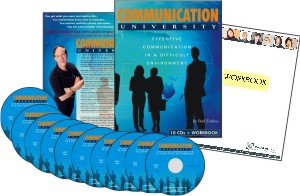
How Promote Your Ideas and ProductsInstantly customize your message to anyone.Have you ever wondered why two people can witness the same automobile accident, yet each person tells the police officer a different rendition of what actually occurred? Or, have you ever wondered why one person reacts to your presentation favorably while another thinks you completely missed the mark? The answer lies in how each person views the world. That is, we all have a unique set of values, beliefs, and past experiences that color how we interpret events. These three factors constitute our “personal perspective.” No mater how similar a group of people may seem to be, their individual perspectives are likely very different. For example, you can have two children growing up in an alcoholic family. One child grows up and becomes an alcoholic, while the other child grows up and never touches a drop of alcohol. When you ask each person why he or she drinks or doesn’t drink, you get the same answer: “Because my parents were alcoholics.” Even though these two people grew up in the same household and experienced the same events, their perspectives are completely opposite, personal perspectives like fingerprints—no two are the same. Unfortunately, most people tend to communicate via their perspective, and not that of the person they’re talking to. As a result, the listener never truly understands what the speaker is saying, and everyone is left scratching their heads and wondering, “Why don’t they get it?” Realize that people can finally “get it” when you communicate using their personal perspective. Here are some guidelines to help. Know your own perspective.Everyone has a personal perspective… including you. Our perspective develops over time, with many factors contributing to it. Some of it comes from learned experiences, some from the media, some from friends, some from conscious decision, and some from upbringing, just to name a few. While no one can pinpoint exactly what their perspective is, they can have a rough idea. For example, in your marketing materials, are there certain things you always stress, such as low prices, geographic location, years of experience, etc? If you see a theme in what you’re communicating to people, chances are that’s a part of your perspective. And if you’ve ever said to yourself, “Why aren’t people buying this product? We have the lowest advertised price,” then you’re likely communicating via your perspective of what’s important and not what’s important to your customers. Once you identify how your perceptions are shaping your communications, you can begin to change. Identify the other person’s perspective.When you know what personal perspective the person is using, you can more effectively communicate your message. To determine someone else’s perspective, you need to ask two key questions: “What is important to you about ________?” “How do you know if _________?” For example, suppose you’re selling someone a car. Rather than lead the discussion by talking about the rebates, the price savings, the dealer incentives, etc., simply ask, “What is most important to you about a new car?” Then be quiet and listen. The person may say “price,” or “gas mileage,” or “safety factors.” Whatever the person says, that’s an indication of his or her perspective. So let’s suppose the customer said that gas mileage was most important. Your next question to ask is, “How do you know if you’re getting good gas mileage?” Again, be quiet and listen. Now you’re uncovering what rules the person uses to match information received against their perspective. The person may say, “When I can fill my tank for less than $50.” With the newly learned information, you can now lead the discussion with gas mileage ratings, gas tank size, and the approximate cost of filling up the car’s gas tank as your main selling points. Those are the factors that are important to the customer, so that’s what your communication must focus on. Adapt to your customers’ perspective.After you do a sampling of all your customers, asking the two key questions just discussed, you can have a good idea of what’s important to your customer base. Now you can phrase your marketing materials to address the specific issues the majority of your customers reveal. While you’ve always been advertising yourself as the low price leader (and experiencing mediocre results) you may learn that your customers value safety over price. With this knowledge, you can now make safety first and foremost in your marketing materials and use the price factor to sway those people who are “on the fence.” Even if your company is large, you likely have market segments with appropriate products/services for each segment. Tailor your messages for each segment accordingly, communicating via your customers’ perspective, and you’ll have less confusion and greater results. Get It? Got It! Good!Even though your natural tendency may be to focus on what you think is important, if you want to get your message clearly communicated to more people, then you need to focus on what the other person thinks is important. So think about your perspective of the world and pinpoint what perspective your customers tend to use. Keep all your communications geared towards your customers’ perspective of the world, and they will finally “get it.”
|
Self-Study Communication Course
-
The psychology of communication
-
Two day seminar condensed to 10 CD's
-
50+ page workbook
- More details...

Partner With Us Links Contact Us Privacy Policy Terms Of Use Site Map
Copyright © 2009 • Paul Endress / Maximum Advantage • 800-788-2068


